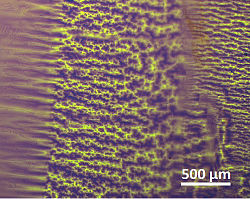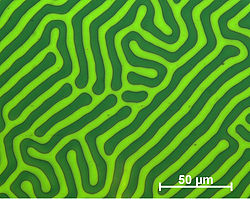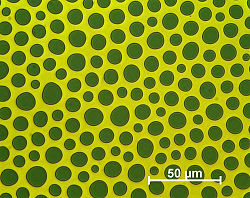- Magnetic domain
-
A magnetic domain describes a region within a magnetic material which has uniform magnetization. This means that the individual magnetic moments of the atoms are aligned with one another and they point in the same direction. When heated above a temperature called the Curie temperature, a piece of ferromagnetic material undergoes a phase transition, and the uniform magnetization within a domain spontaneously disappears: each atom has its own direction of magnetic moment, independent from its neighbouring atoms (typical of the paramagnetic state). Magnetic domain structure is responsible for the magnetic behavior of ferromagnetic materials like iron, nickel, cobalt and their alloys, ferrites etc. The regions separating magnetic domains are called domain walls, where the magnetisation rotates coherently from the direction in one domain to that in the next domain.
Contents
Development of domain theory
Main article: Domain theory of ferromagnetismMagnetic domain theory was developed by French physicist Pierre-Ernest Weiss[1] who in 1906 suggested existence of magnetic domains in ferromagnets.[2] He suggested that large number of atomic magnetic moments (typically 1012-1018)[citation needed] were aligned parallel. The direction of alignment varies from domain to domain in a more or less random manner although certain crystallographic axis may be preferred by the magnetic moments, called easy axes. Weiss still had to explain the reason for the spontaneous alignment of atomic moments within a ferromagnetic material, and he came up with the so-called Weiss mean field : he assumed that a given magnetic moment in a material experienced a very high effective magnetic field due to the magnetization of its neighbours. In the original Weiss theory the mean field was proportional to the bulk magnetization M, so that

where
 is the mean field constant. However this is not applicable to ferromagnets due to the variation of magnetization from domain to domain. In this case, the interaction field is
is the mean field constant. However this is not applicable to ferromagnets due to the variation of magnetization from domain to domain. In this case, the interaction field is
Where Ms is the saturation magnetization at 0K.
Later, the quantum theory made it possible to understand the microscopic origin of the Weiss field. The exchange interaction between localized spins favored a parallel (in ferromagnets) or an anti-parallel (in anti-ferromagnets) state of neighbouring magnetic moments.
Energy considerations
The existence of magnetic domains is a result of energy minimisation. Landau and Lifshitz [1] proposed theoretical domain structures based on a minimum energy concept, which forms the basis for modern domain theory. The primary reason for the existence of domains within a crystal is that their formation reduces the magnetic free energy. In the simplest case for such a crystal, the energy, E, is the sum of several free energy terms:
 (3)
(3)
where Eex is the exchange energy, Ek is the magnetocrystalline anisotropy energy, Eλ is the magnetoelastic energy, ED is the magneto-static energy, and EH is the Zeeman energy, i.e. the energy of the magnetic material in the presence of an external applied field. A wall energy Ew could also be added. However, since Ew comprises Eex and Ek, it is not necessary to include Ew as a separate term in the equation. [3]
- Magneto-static energy: This is a self-energy, due to the interaction of the magnetic field created by the magnetization in some part of the sample on other parts of the same sample. Intrinsically, it has exactly the same nature as the "Zeeman energy" but the interaction of the material with itself is put in the magnetostatic energy whereas the interaction with the external magnetic field is put in the "Zeeman energy". This energy term is the only one responsible for the presence of magnetic domains in magnetic materials. Minimizing its value requires that the magnetization in the material makes closed loops, with the magnetization staying parallel to the sample edges.
- Magnetoelastic anisotropy energy: This energy is due to the effect of magnetostriction, a slight change in the dimensions of the crystal when magnetized. This causes elastic strains in the lattice, and the direction of magnetization that minimizes these strain energies will be favoured.
- Magnetocrystalline anisotropy energy: The crystal lattice is 'easy' to magnetize in some directions and 'hard' to magnetize in others. Magnetization in the easy directions lowers this energy.
- Zeeman energy: Energy resulting from the interaction between the magnetic material and an externally applied magnetic field.
Domain observation
There are many ways to observe magnetic domains. Each method has a different application because not all domains are the same. In condensed matter, domains can be circular, square, irregular, elongated, and striped, all of which have varied sizes and dimensions. Large domains, within the range of 25-100 micrometers can be easily seen by Kerr microscopy, which applies a physical phenomenon called the magneto-optic Kerr effect. Other domains, such as domains within the range of a few nanometers can be documented by the use of magnetic force microscopy.
Images
Magnetooptical images of different domain structures
Domain structure of a shape memory alloy SMA (recorded using CMOS-MagView)See also
- Weiss domains
- Magnetostatic energy
- Racetrack memory
References
- ^ P. Weiss (1906) La variation du ferromagnetisme du temperature, Comptes Rendus, 143, p.1136-1149, cited in Cullity, 2008, p.116
- ^ Cullity; C. D. Graham (2008). Introduction to Magnetic Materials, 2nd ed.. New York: Wiley-IEEE. pp. 116. ISBN 0471477419. http://books.google.com/books?id=ixAe4qIGEmwC&pg=PA116&lpg=PA116.
- ^ Carey R., Isaac E.D., Magnetic domains and techniques for their observation, The English University Press Ltd, London, (1966).
- Jiles, David (1998). Introduction to magnetism and magnetic materials. London: Chapman & Hall. ISBN 0-412-79860-3.
External links
- Interactive Java tutorial on magnetic domains National High Magnetic Field Laboratory
- Magnetismus und Magnetooptik a German text about magnetism and magneto-optics
Categories:- Magnetic ordering
Wikimedia Foundation. 2010.





